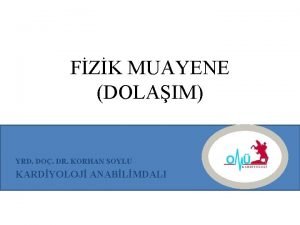Sinus of Valsalva Fistula Without Aneursym Mark A

- Slides: 1

Sinus of Valsalva Fistula Without Aneursym Mark A. Navarro M. D. , Joseph R. Sweigart M. D. , Becky E. Selling, Lucy B. Esberg M. D. , Edward Havranek M. D. , Whitney Juselius M. D. Presentation • 18 year old male with no medical history was admitted with syncope • Frequent episodes of lightheadedness lasting around 1 minute for the past 1 month LA • He took no medications, never smoked, rarely drank, and never used drugs • No known family history of cardiac disease Ao LV • 2 episodes daily at the time of presentation • No pain, diaphoresis, nausea, vomiting, or loss of bladder or bowel control LA o. Ao LV Fistula IV S RV RV Physical Exam and Data • Temperature 36. 5° Celsius, 72 beats per minute, 118/47 mm. Hg, 14 breaths per minute, oxygen saturation 96 percent on room air • Continuous machinery murmur audible throughout the precordium with palpable thrill along the left sternal border • Exam otherwise normal with normal labs • Chest X-ray showed cardiomegaly • EKG with RSR’ in V 1 and V 2 • Transthoracic echocardiogram showed membranous ventricular septal defect (VSD) but no explanation for the machinery murmur • Trans-esophageal echocardiogram showed VSD as well as sinus of valsalva (So. V) fistula between the aorta to right ventricle Hospital Course • Decision made to pursue surgical correction • Catheterization documented pulmonary to systemic blood flow ratio of 2. 2: 1 • Operation revealed small VSD and fistula near the right coronary ostium separated by a small annulus adjacent to the right coronary cusp • VSD was repaired with synthetic material • So. V fistula was repaired but with subsequent aortic insufficiency requiring placement of mechanical aortic valve • No aneurysmal dilation of So. V visualized Discussion • Fistulous connection between the aorta and the right ventricle without aneurysm is quite rare • So. V fistula is most often a congenital defect and part of a spectrum of anomalies including So. V aneurysm • 2/3 of So. V aneurysms occur in males and up to 80% occur in the right coronary sinus • Most common symptoms are dyspnea, fatigability and chest pain. • The most common congenital anomaly associated with So. V aneurysm is VSD which is present in 12 -53% of cases • Uncomplicated peri-operative course Conclusions References • Moustafa, S, Mookadam, F, Copper, L et al. Sinus of Valsalva Aneurysms – 47 Years of a Single Center Experience and Systematic Overview of Published Reports. The American Journal of Cardiology. 2007; 99: 1159 -1164. • Lee, S, Lin, T, Chiu, C, et al. Ruptured Aneurysm of the Sinus of Valsalva into the Right Atrium without Ventricular Septal Defect: A Case Report and Literature Review. Kaohsiung J Med Sci. 2005; 21: 517 -521. • Sukakibura, S, Konno, S. Congenital aneurysm of the sinus of valsalva associated with ventricular septal defect – Anatomical aspects. American Heart Journal. 1968; 75: 595 -603. • So. V fistulization is likely part of a spectrum of congenital anomalies including So. V aneurysm and often coinciding with VSD • Unexpected symptoms and exam findings should be investigated thoroughly until an explanation is discovered • This is a rare case of sinus of valsalva fistula without evidence of aneursymal formation.

